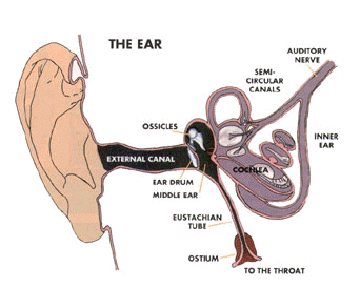Dr. Al Parmet
The human sense of hearing allows us to detect sound in a range from 16 to 20,000 Hz. Within the animal kingdom this is not a very broad spectrum; but for the purposes of human speech, it’s more than adequate. The entire spectrum of the human voice ranges from 250 Hz to 2,000 Hz. Still, because our hearing is an important defensive tool — for warning of danger — and not just for normal verbal communication, it must detect more than the sound of another human being.
Compared to human speech, aircraft noise is different in its intensity and frequency. From the low-pitched rumble of tires to the high-pitched whine of jets, the sounds of aviation give us important cues to events in our environment. A burble on the wing or the screech of a reed warns us of an impending stall. A blaring horn reminds us to check the position of the landing gear. In addition, our ability to hear in stereo enables us to position these sounds in space and gives us a sense of direction and distance.

However, the very intensity of aviation’s aural assault threatens our hearing. Extremely loud noises can damage the sensitive nerves in the inner ear. This small organ of hearing, called the cochlea because of its snail shell shape, is embedded deep in the skull at the end of the inner ear canal. The sound we hear travels down the ear canal and through the 30:1 amplifying system of the eardrum. In the middle ear, three small bones transfer the sound’s vibrations to the cochlea and the hair-like cells that line it. Sound energy that is too loud or intense can damage and break off these hairs. Because they are nerves, they do not grow back, once damaged; and they cannot be repaired.
What is the limit to the noise we can endure safely? The Occupational Safety and Health Administration (OSHA) says 90 decibels (dB) is the maximum sound level a human can safely tolerate without risk of injury. Roughly speaking, 90 dB of ambient noise is noise so loud that you’d have to shout to communicate with someone who’s at arm’s length. The decibel is named for Alexander Graham Bell, and it’s on a logarithmic scale, which means normal conversation is 60 dB and a faint whisper is 40 dB. For most human beings the absolute minimum threshold for hearing lies at 10 to 20 dB.
How loud can aviation be? At full power a commercial jet engine can easily produce sound energy in excess of 130 dB, and military jets at afterburner can exceed 140 dB. These sounds are loud enough to cause permanent hearing loss with only a few seconds of exposure. The sound levels inside the cockpit of a light aircraft vary widely. Typically, pilots are subjected to 80 to 95 dB, but the level may be higher or lower depending on the size of the engine and the degree of sound insulation.
To avoid damaging our hearing we need protection. The simplest solution is to simply “stick it in your ear”– ear plugs, that is.
Ear plugs are simple, effective, and inexpensive protective devices, and almost every brand reduces the sound you hear by 15 to 20 dB. In other words, if you are exposed to 95 dB of noise, what your ear actually hears will be 75 to 80 dB.
This reduction doesn’t mean you are unable to hear at all while wearing ear protection. Because your ear is more sensitive to voice frequencies, you’ll actually be able to hear spoken communications more clearly while wearing hearing protection. If you find a comfortable pair of earplugs, you will probably do what I do and wear them while driving in city traffic, which actually lets you hear the radio a little better, or while mowing the lawn.
The next step up in aviation hearing protection is the noise-attenuating headset. Rather than sticking foam plugs into your ears, you can surround your ears with a headset’s noise-insulated cups.
For headsets to reduce the noise effectively, you must have a good seal between the ear cups and your head. To create a good seal, manufacturers put a foam- or gel-filled seal between the ear cup and your head. However, any gaps, such as those caused by the ear pieces of sunglasses, let noise “leak” in. Noise-attenuating headsets reduce the noise you hear by roughly 20 to 25 dB.
As a bonus, you get hands-free communication thanks to the speakers in the ear cups and the boom-mounted microphone.
A newer and more expensive approach to hearing protection is the active noise reduction (ANR) headset. These headsets not only provide an excellent seal around the ear to prevent noise from entering (often called passive attenuation”), they “listen” to ambient noise and generate a “counter wave” that blanks out the noise entirely. This is not white noise like the sound you hear on a TV channel after a broadcast channel signs off. Instead, a counter wave is “destructive interference,” a generated sound wave of exactly the same-shaped intensity as the ambient noise — but it’s out of phase. In other words, when the ambient noise wave form is going up, the destructive interference wave form is going down, and the two cancel each other out.
The process of active noise cancellation is a lot like folding your hand in a small puddle of water and generating waves with each finger. As the waves approach the center, they either combine and intensify or they cancel each other so no wave exists at all. The latter effect is what “active” headsets do, and the result is an extremely valuable and useful tool to protect your ears for many years of flying to come.
Regardless of what hearing protection you choose, the important message to hear is — use it whenever you fly. Some aircraft may not sound “loud,” but the damaging effect of noise builds with time — and cannot be reversed. Because our sense of hearing is “one per customer,” we need to protect it — not abuse it.
Dr. Parmet can be reached via email at: info @ leftseat .com



